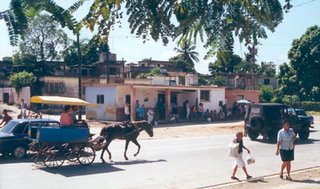ANATOMIA DEL APARTHEID INFORMATIVO CUBANO
18-11-2005
Esto explica el enorme atraso de Cuba en los campos de la información y las comunicaciones, en un momento de avance acelerado en el mundo con la Internet y la telefonía móvil. Una paradójica situación que se presenta en una nación en otros tiempos pionera de la telefonía, la radio y la televisión en Latinoamérica...
Anatomía del apartheid informativo cubano
Por: Oscar Espinosa Chepe Con la aparición y desarrollo de las nuevas tecnologías de la información y las comunicaciones, está en marcha, con un avance incontenible, una revolución transformadora de todos los aspectos de la vida humana. Mediante las nuevas técnicas las distancias desaparecen, y personas que habitan en las antípodas pueden comunicarse prontamente vía satélite, con tal eficiencia y nitidez que asemejan conversaciones y contactos entre vecinos. Los costos de las conexiones telefónicas se reducen a través del uso de la telefonía móvil, que hacen innecesarias las enormes inversiones requeridas anteriormente. Así se benefician los países más pobres.
Con la aparición y desarrollo de las nuevas tecnologías de la información y las comunicaciones, está en marcha, con un avance incontenible, una revolución transformadora de todos los aspectos de la vida humana. Mediante las nuevas técnicas las distancias desaparecen, y personas que habitan en las antípodas pueden comunicarse prontamente vía satélite, con tal eficiencia y nitidez que asemejan conversaciones y contactos entre vecinos. Los costos de las conexiones telefónicas se reducen a través del uso de la telefonía móvil, que hacen innecesarias las enormes inversiones requeridas anteriormente. Así se benefician los países más pobres.
Estos progresos constituyen valiosos aportes para el florecimiento de la ciencia, la técnica, la cultura, la educación, el comercio, la economía y el pensamiento humano en todas sus variantes, aún cuando, como todos los desarrollos humanos positivos, son factibles de ser utilizados con fines perversos, sobre lo cual lógicamente debe existir conciencia y estar alertas.
En la economía especialmente, la posibilidad multiplicada de intercambiar y transmitir información, así como llegar con ella a los más recónditos lugares, abre horizontes ilimitados para el incremento de la riqueza mediante el engrosamiento multidimensional de la productividad, con lo cual las perspectivas de reducción de la pobreza y la marginación a escala mundial aumentan ostensiblemente.
En las áreas del entendimiento, la cooperación y la concordia entre los seres humanos es donde podrían ser más significativamente beneficiosos los logros en materia de información y comunicaciones. El desconocimiento de las realidades nacionales de los pueblos a menudo ha sido fuente de falsas interpretaciones y desconfianza, luego utilizadas por supuestos mesías para atizar odios, promover la inestabilidad y satisfacer la ambición de mando.
Por ello, al tomar el poder, el totalitarismo en sus diversas variantes cierra paulatinamente todas las vías de información y comunicación al pueblo sometido, para de esa forma tergiversar la realidad, adulterar la historia y fabricar mitos. Ambiente indispensable para activar la represión contra los “ciudadanos obedientes” y ejercer un control absoluto sobre la sociedad.
Esto explica el enorme atraso de Cuba en los campos de la información y las comunicaciones, en un momento de avance acelerado en el mundo con la Internet y la telefonía móvil. Una paradójica situación que se presenta en una nación en otros tiempos pionera de la telefonía, la radio y la televisión en Latinoamérica.
Quien abrigue dudas acerca de lo expuesto podría consultar el Informe sobre Desarrollo Humano (IDH) 2005, recientemente publicado por el Programa de Naciones Unidas para el Desarrollo (PNUD), donde se encuentran datos estadísticos de Cuba y los países pertenecientes a ese organismo internacional. En el IDH puede constatarse que Cuba posee 64 líneas telefónicas por cada mil habitantes, muy por debajo de naciones de América Latina, el Caribe y Africa, como México (160), Ecuador (122), Colombia (179), Panamá (122), Barbados (497), Chile (221), Bahamas (415), Perú (67), Venezuela (111), El Salvador (113), Cabo Verde (156), Namibia (66), Botswana (75).
Respecto a los suscriptores a la telefonía móvil y usuarios de Internet, los datos mostrados en el Cuadro 1 hablan por sí solos. Baste subrayar que los índices de Cuba son espectacularmente inferiores a países tan pobres y subdesarrollados como Haití, Viet Nam, Mongolia y algunos africanos.
( Nota del Autor del blog
En la foto un chiste cruel pero cierto: cubano " de a pie" tratando de entrar en Internet; el autor de este blog entró por primera vez en Internet cuando llegó al exilio pese haber sido profesor de Computación en Cuba. ¡ Mis compañeros de aula del curso de programación en PL/SQL Oracle 9i ,que me enseñaron "extracurricularmente" a enviar e-mail, no me creían ! )
CUADRO 1
Suscriptores de telefonía móvil y usuarios de Internet por mil habitantes 
País Suscrip. T.móvil- Usuarios de Internet
Cuba 3 - 9
Paraguay 299 - 20
Haití 38- 18
Barbados 19 - 371
Costa Rica 181- 288
Bahamas 367 - 265
Perú 106 - 104
México 295 - 120
Ecuador 189 - 46
Viet Nam 34 - 43
Mongolia 130 - 58
Honduras 55 - 40
Surinam 320 - 44
Gabón 224 - 26
Namibia 116- 34
Sao T,y P. 32 - 99
Bhutan 11 - 20
Togo 44 - 42
Swazilandia 84 - 26
Naciones menos desarrolladas del mundo (promedio):
16 - 4
Fuente: Informe sobre Desarrollo Humano (IDH) 2005. Programa de las Naciones Unidas para el Desarrollo (PNUD)
El increíble bajo nivel actual de Cuba en los campos de telecomunicaciones e informática, uno de los más mediocres del mundo, es una consecuencia directa de las políticas restrictivas en materia informativa vigentes al interior del país. La venta de computadoras está estrictamente prohibida a los nacionales, aún cuando sean pagadas en divisas convertibles.
La conexión a Internet se restringe con permisos especiales y precios impagables en moneda convertible para un ciudadano corriente (ver Cuadro 2). Tarifas vigentes conocidas establecen 10 horas de Internet por 30 US$, con la hora extra a razón de tres US$.
Existen cibercafés, pero no en todos se permite el acceso a nacionales. Donde son admitidos, el servicio es cobrado en moneda convertible a precios inalcanzables para la mayoría de la población. En la ciudad de La Habana, el cibercafé del Capitolio Nacional, a 6.25 US$ la hora constituye el servicio más módico. En otros lugares los precios por hora son los siguientes: Hotel Coolí 7.50 US$, Hotel Habana Trip 11.25 US$, Hotel Meliá Cohiba 15.00 US$, Habana Meliá 12.50 US$
Cuadro 2
Salarios y pensiones mensuales pagados en Cuba (equivalencia en US$) *
Mínimo - Medio
Salarios 11.25 - 6.70
Pensiones 7.50 - 9.02
* Julio 2005
En Cuba, como es conocido, persiste una dualidad monetaria. Con el establecimiento del peso convertible (CUC) como único medio de pago en las tiendas de venta en divisas, oficialmente cotizado a razón de 0.80 CUC por dólar US, la situación de los cubanos que no tienen cómo obtener divisas convertibles continúa siendo muy difícil. El CUC, en sentido general, resulta inasequible por medio del trabajo. Los nacionales sólo pueden obtenerlo a través del recibo de divisas convertibles (remesas, propinas y otras vías, algunas veces ilegales).
Por otra parte, resulta innegable que en los últimos años el estado cubano ha suministrado computadoras personales a las escuelas para la enseñanza de la informática, así como se han creado clubes de computación y electrónica, y una facultad universitaria para el estudio superior de la ciencia informática, por supuesto, muy selectiva esta última en la admisión de los alumnos, en particular en el aspecto político.
Ello demuestra que en el gobierno existe una clara conciencia de la importancia de las nuevas tecnologías de la información y las comunicaciones para una sociedad moderna y avanzada. Las limitaciones que impone a Internet y las comunicaciones con el exterior responden a su temor a la información como vehículo que podría amenazar el poder absoluto ejercido durante tantos años sobre la sociedad cubana. Esta contradicción, presente también en la educación en general, la resuelve en última instancia a través del aislamiento y bloqueo informativo al pueblo cubano.
Los mecanismos descritos para impedir a los cubanos el acceso a Internet y a otros medios de comunicación no son únicos. Incluso, se limita el acceso a Internet de los “ciudadanos favorecidos”. Páginas Web son bloqueadas tecnológicamente, aprovechando que los servidores son estatales. Para muchos expertos la razón de que sea muy reducido el número de cibercafés disponibles responde al interés de mantener el control más estricto sobre los mensajes enviados y recibidos y la navegación por la red de redes.
En otras esferas de la electrónica, los controles son también muy rígidos. A estas alturas del desarrollo tecnológico mundial, el pueblo cubano todavía no posee acceso a la televisión por cable ni al servicio vía satélite, fundamentalmente reservados para los hoteles de turistas y ciudadanos extranjeros residentes en Cuba. La venta en las tiendas de divisas de videocaseteras y fotocopiadoras a los nacionales está estrictamente prohibida por regulaciones especiales.
En cuanto a la telefonía, los motivos para tan pocas líneas y un índice insignificante de telefonía móvil por mil habitantes no se deben tanto a la capacidad de inversión –realmente reducida- sino a motivaciones políticas, semejantes a las que han influido tan negativamente en el desarrollo de la informática.
Al perder las enormes subvenciones provenientes del Este de Europa, el gobierno cubano estableció desde hace algunos años acuerdos con compañías telefónicas extranjeras, especialmente estadounidenses, para facilitar la comunicación con el exterior, pero imponiendo precios exorbitantes (ver Cuadro 3) en momentos en que una llamada desde Estados Unidos a Argentina no sobrepasa los nueve centavos de US$ el minuto (6 centavos de US$ a Buenos Aires), de acuerdo a ofertas de algunas empresas del ramo.
Cuadro 3
Tarifas de telefonía básica para llamadas internacionales desde Cuba US$/minuto
Región Telesección - Operadora internacional *
América del Norte 2.4 - 3.71
América Central, México, Caribe 3.40 - 5.07
América del Sur 4.45 - 6.63
Resto del mundo 5.85 - 8.78
* Si la llamada es solicitada con una persona determinada, se adiciona el importe de un minuto.
Fuente: Directorio Telefónico Oficial 2005-2006, Empresa de Telecomunicaciones de Cuba, S.A.
En pocos lugares del mundo el experimento totalitario ha sido tan severo y abarcador como en Cuba, especialmente en materia informativa, donde se ha implantado un control absoluto sobre todos los medios de prensa, convertidos en un coro de repetidores de consignas elaboradas para desinformar a la población. Da pena que a esta infame e indigna tarea se presten intelectuales y periodistas cubanos que, inmovilizados por el miedo o con el objetivo de preservar privilegios, permanecen ciegos, sordos y mudos ante el drama nacional, y prestos a servir de cipayos ideológicos del gobierno, en un momento en que el país se desmorona a pedazos política, social y económicamente, con desastrosas consecuencias para la vida espiritual de los ciudadanos y la propia existencia de la nación.
La priorización del desarrollo de las nuevas tecnologías de la información y las comunicaciones es vital para el futuro nacional, en un mundo cada vez más dinámico y competitivo, dependiente en alto grado del acceso al conocimiento con rapidez y precisión, objetivo únicamente lograble en un ambiente de libertad y democracia, donde sea extirpado de raíz el totalitarismo, sistema que por su intrínseca naturaleza opresora requiere de la desinformación, el engaño y la mentira como instrumentos básicos de dominación y control absoluto sobre los pueblos.
********************
Nota del Autor del blog:
En la foto el autor del blog con Martha Beatriz Roque Cabello en una reunión del Grupo de Economistas del Centro de Formación Cívica y Religiosa de la Diócesis de Pinar del Río. El autor y la destacada líder, economista de profesión, han abordado de manera independiente y en determinados trabajos la situación socioeconómica de Cuba antes y después del año 1959, llegando a similares conclusiones.
Hay personas, algunas no simpatizantes del régimen cubano, que argumentan a favor de dicho régimen diciendo que Cuba ha progresado en todos estos años, pues hoy en día, en Cuba hay más televisores por habitantes que antes de 1959, mueren menos niños en su primer año de vida que antes de 1959, etc.. . No se dan cuenta de que ha pasado casi medio siglo y que la ciencia, la tecnología, etc. que era novedosa en esa época, ya es obsoleta y que los parámetros de aquella época, no deben compararse de manera ABSOLUTA sino más bien RELATIVA ( o sea, comparados con los de los demás países) para darnos más información sobre lo que hemos avanzado, atrasado, etc. durante este período. Todo eso sin tener en cuenta, claro está, el altísimo costo que ha tenido que pagar el pueblo cubano en cuanto a la falta de libertades, daño a la dignidad, sangre y sufrimientos durante este casi medio siglo de dictadura totalitaria.
Por otra parte, debemos estar claro por ejemplo, que el tener un televisor hoy en día no equivale socialmente a lo que era tenerlo en los años 50s cuando todavía era novedosa la TV. El tener antes de 1959 un simple TV equivale, aproximadamente, a tener hoy acceso a una Televisión digitalizada con un millar de canales a tu disposición con pantalla de plasma, última tecnología de sonido etc.; otro ejemplo: el tener un receptor de radio hoy no tiene el mismo impacto social que el que tuvo en los años 30 del siglo XX . En los años cincuenta un teléfono quizás tuvo, aproximadamente, el mismo impacto que el que tiene hoy el poseer un celular o teléfono móvil de última generación con todas las funciones que hoy pueden realizar en cuanto a comunicaciones, trasmisiones de datos, TV, e-mail, acceso a cuentas bancarias, etc.
En los años 50s, no necesariamente 1958, Cuba era, por ejemplo, el cuarto país de Latinoamérica en teléfonos por habitante: uno por cada 38 habitantes. Cuba también en esos años era el primer país en América Latina en televisores por habitante: uno cada 25 habitantes. Esa posición RELATIVA con respecto a los demás países latinoamericanos ¿ se habrá mantenido ?. El siguiente informe elaborado por el Buro de Asuntos Interamericanos del Departamento de Estado los Estados Unidos de América, tomando como fuente las Naciones Unidas , nos dice que NO. La otra pregunta, cuya respuesta es necesariamente especulativa, sería ¿ Qué parámetros concretamente tendría hoy Cuba de haber continuado su desarrollo, la anterior y muy joven república cubana ?. No obstante el carácter especulativo de cualquier respuesta si se puede adelantar y asegurar algo: hubieran sido mejores que los actuales.
A continuación el documento que fue liberado por el Buró de Asuntos Interamericanos del Departamento de Estado del Gobierno de los Estados Unidos de América. Los datos tienen por fuente las Naciones Unidos: el único inconveniente es que está escrito en lengua inglesa, pero con uno de los tantos traductores automáticos que existen en Internet, usted puede leerlos.
ZENITH AND ECLIPSE: A COMPARATIVE LOOK AT SOCIO-ECONOMIC CONDITIONSIN PRE-CASTRO AND PRESENT DAY CUBA
(As released by the Bureau of Inter-American Affairs, Department of State)January 12, 1998
SUMMARY AND INTRODUCTION
An enduring myth is that 1950's Cuba was a socially and economically backward country whose development was jump-started by the Castro government. In fact, according to readily-available historical data, Cuba was a relatively advanced country in 1958, certainly by Latin American standards and, in some areas, by world standards. The data appear to show that Cuba has at best maintained what were already high levels of development in health and education, but at an extraordinary cost to the overall welfare of the Cuban people. These include access to "basics" such as adequate levels of food and electricity, but also access to consumer goods, the availability of which have increased significantly in other Latin American countries in recent decades.
development was jump-started by the Castro government. In fact, according to readily-available historical data, Cuba was a relatively advanced country in 1958, certainly by Latin American standards and, in some areas, by world standards. The data appear to show that Cuba has at best maintained what were already high levels of development in health and education, but at an extraordinary cost to the overall welfare of the Cuban people. These include access to "basics" such as adequate levels of food and electricity, but also access to consumer goods, the availability of which have increased significantly in other Latin American countries in recent decades.
It is true that Cuba's infant mortality rate is the best in Latin America today, but it also was the best in Latin America -- and the 13th lowest in the world -- in pre-Castro Cuba. Cuba also has improved the literacy of its people, but Cuba had an excellent educational system and impressive literacy rates in the 1950's.
On the other hand, many economic and social indicators have declined since the 1959 revolution. Pre-Castro Cuba ranked third in Latin America in per capita food consumption; today, it ranks last. Per capita consumption of cereals, tubers, and meat are today all below 1950's levels. The number of automobiles in Cuba has fallen since the 1950's -- the only country in Latin America for which this is the case. The number of telephone lines in Cuba also has been virtually frozen at 1950's levels. Cuba once ranked first in Latin America and fifth in the world in television sets per capita. Today, it barely ranks fourth in Latin America and is well back in the ranks globally.
Cuba's rate of development of electrical power since the 1950's ranks behind every other country in Latin America except Haiti. Cuba is the only country in the hemisphere for which rice production today is lower than it was four decades ago. By virtually any measure of macroeconomic stability, Cuba was in far better shape in 1958 than it is today. Finally, the Castro government shut down what was a remarkably vibrant media sector in the 1950's, when the relatively small country had 58 daily newspapers of differing political hues and ranked eighth in the world in number of radio stations.
METHODOLOGY
This paper assesses Cuba's level of development in a variety of economic and social indicators during the revolutionary period (1959-present), especially relative to that of other countries during the same period. It relies most extensively on UN data, particularly from the statistical yearbook and demographic yearbook, which are considered among the most prestigious data compendiums in the development field. Trade data is derived from the IMF's Direction of Trade Statistics, which provides a consistent data series dating back to the 1950's. For the various international comparisons and rankings listed below, only those countries acquiring independence prior to 1958 and having relatively consistent data available for the period 1955-present have been included. (The former stipulation excludes many highly-developed Caribbean countries from consideration.)
HEALTH
The health care system is often touted by many analysts as one of the Castro government's greatest achievements. What this analysis ignores is that the revolutionary government inherited an already-advanced health sector when it took power in 1959.
Cuba's infant mortality rate of 32 per 1,000 live births in 1957 was the lowest in Latin America and the 13th lowest in the world, according to UN data. Cuba ranked ahead of France, Belgium, West Germany, Israel, Japan, Austria, Italy, Spain, and Portugal, all of which would eventually pass Cuba in this indicator during the following decades.
Today, Cuba remains the most advanced country in the region in this measure, but its world ranking has fallen from 13th to 24th during the Castro era, according to UN Data. Also missing from the conventional analysis of Cuba's infant mortality rates is its staggering abortion rate -- 0.71 abortions per live birth in 1991, according to the latest UN data -- which, because of selective termination of "high-risk" pregnancies, yields lower numbers for infant mortality. Cuba's abortion rate is at least twice the rate for the other countries in the table below for which data are available.
In terms of physicians and dentists per capita, Cuba in 1957 ranked third in Latin America, behind only Uruguay and Argentina -- both of which were more advanced than the United States in this measure. Cuba's 128 physicians and dentists per 100,000 people in 1957 was the same as the Netherlands, and ahead of the United Kingdom (122 per 100,000 people) and Finland (96).
Unfortunately, the UN statistical yearbook no longer publishes these statistics, so more recent comparisons are not possible, but it is completely erroneous to characterize pre-Revolutionary Cuba as backward in terms of healthcare.
WORLD: INFANT MORTALITY (DEATHS PER 1,000 LIVE BIRTHS)
1957 - (1990-95)
JAPAN 40 - 4
ICELAND 16 - 5
SWEDEN 18 - 5
FINLAND 28 - 5
SWITZERLAND 23 - 6
BELGIUM 36 -
GERMANY (A) 36 - 6
NETHERLANDS 18 - 7
AUSTRALIA 21 - 7
DENMARK 23 - 7
UNITED KINGDOM 24 - 7
CANADA 31 - 7
IRELAND 33 - 7
FRANCE 34 - 7
LUXEMBOURG 39 - 7
AUSTRIA 44 - 7
SPAIN 53 - 7
NORWAY 21 - 8
ITALY 50 - 8
UNITED STATES 26 - 9
ISRAEL 39 - 9
GREECE 44 - 10
PORTUGAL 88 - 10
CUBA 32 - 12
MALAYSIA 76 - 13
(A) - FOR 1957, INCLUDES ONLY FRG. SOURCE: UNITED NATIONS.
EDUCATION
Cuba has been among the most literate countries in Latin America since well before the Castro revolution, when it ranked fourth. Since then, Cuba has increased its literacy rate from 76 to 96 percent, which today places it second only to Argentina in Latin America. This improvement is impressive, but not unique, among Latin American countries. Panama -- which ranked just behind Cuba in this indicator during the 1950's -- has matched Cuba's improvement when measured in percentage terms.
LATIN AMERICA: LITERACY RATES (A) (PERCENT)
(1950-53) - 1995
ARGENTINA 87 (B) - 96
CUBA 76 - 96
CHILE 81 - 95
COSTA RICA 79 - 95
PARAGUAY 68 - 92
COLOMBIA 62- 91
PANAMA 72 - 91
ECUADOR 56 - 90
BRAZIL 49 - 83
DOMINICAN REPUBLIC 43 - 82
EL SALVADOR 42- 72
GUATEMALA 30 - 56
HAITI 11 - 45
(A) - DATA FOR 1950-53 ARE AGE 10 AND OVER.
DATA FOR 1995 ARE AGE 15 AND OVER, REFLECTING A CHANGE IN COMMON USAGE OVER THIS PERIOD.
(B) - 1947 DATA, THE LATEST AVAILABLE, ARE FOR AGE 14 AND OVER. SOURCE: UNITED NATIONS.
CONSUMPTION
Rationing has been a staple of Cuban life since the early 1960's. During the early 1990's, Cuba's food consumption deteriorated sharply, when massive amounts of Soviet aid were withdrawn. On its own without Soviet largesse and abundant food imports, Cuban agriculture was paralyzed by a scarcity of inputs and poor production incentives resulting from collectivism and the lack of appropriate price signals. In pre-Castro Cuba, by contrast, food supplies were abundant. The 1960 UN Statistical yearbook ranked pre-Revolutionary Cuba third out of 11 Latin American countries in per capita daily caloric consumption. This was in spite of the fact that the latest available food consumption data for Cuba at the time was from 1948-49, almost a decade before the other Latin American countries' data being used in the comparison. Looking at the same group of 11 countries today, Cuba ranks last in per capita daily caloric consumption, according to the most recent data available from the UN FAO. Indeed, the data show Cuba with a poorer food supply situation than even Honduras.
LATIN AMERICA: PER CAPITA FOOD CONSUMPTION (CALORIES PER DAY) LATEST DATA
(1954-57) - 1995
MEXICO 2420 - 3135
ARGENTINA 3100 - 3110
BRAZIL 2540 - 2834
URUGUAY 2960 - 2826
CHILE 2330 - 2769
COLOMBIA 2050 - 2758
PARAGUAY 2690 - 2560
VENEZUELA 1960 - 2442
ECUADOR 2130 - 2436
HONDURAS 2260 - 2359
CUBA 2730 (A) - 2291
(A) - FOR 1948-49.
SOURCE: UN FAO FOOD BALANCE SHEETS
(Nota del autor del blog: para conocer que esas calorías no se obtenían en Cuba tomando " agua con azúcar " puede leer mi artículo " La libreta del desabastecimiento " , el cual se encuentra dentro de los primero trabajos publicados en este blog)
A closer look at some basic food groups reveals that Cubans now have less access to cereals, tubers, and meats than they had in the late 1940's. According to 1995 UN FAO data, Cuba's per capita supply of cereals has fallen from 106 kg per year in the late 1940's to 100 kg today, half a century later. Per capita supply of tubers and roots shows an even steeper decline, from 91 kg per year to 56 kg. Meat supplies have fallen from 33 kg per year to 23 kg per year, measured on a per capita basis.
Although some would blame Cuba's food problems on the U.S. embargo, the facts suggest that the food shortages are a function of an inefficient collectivized agricultural system -- and a scarcity of foreign exchange resulting from Castro's unwillingness to liberalize Cuba's economy, diversify its export base, and pay off debts owed to its Japanese, European, and Latin American trading partners during the years of abundant Soviet aid. This foreign exchange shortage has severely limited Cuba's ability to purchase readily-available food supplies from Canada, Latin America, and Europe. The U.S. Embargo has added, at most, relatively small increases in transportation costs by forcing Cuba to import food from non-U.S. sources elsewhere in the hemisphere.
The statistics on the consumption of nonfood items tell a similar story. The number of automobiles in Cuba per capita has actually fallen since the 1950's, the only country in the hemisphere for which this is the case. (Unfortunately, the latest available data for Cuba are from 1988.) UN data show that the number of automobiles per capita in Cuba declined slightly between 1958 and 1988, whereas virtually every other country in the region -- with the possible exception of Nicaragua -- experienced very significant increases in this indicator. Within Latin America, Cuba ranked second only to Venezuela in 1958, but by 1988, had dropped to ninth.
The 1988 data on automobiles also reveal that countries in Asia and Europe that once ranked far behind Cuba in this measure have since surpassed Cuba by a wide margin. Japan, with four cars per 1,000 inhabitants in 1958, was far behind Cuba (24) that year, but by 1988, Japan's number had grown to 251, whereas the figure for Cuba remained frozen at its 1958 level. Similar comments could be made for Portugal (increased from 15 in 1958 to 216 in 1988), Spain (increased from six to 278), and Greece (increased from four to 150). Indeed, Italy's 29 cars per capita was not far ahead of Cuba's 24 in 1958, but by 1988, Italy boasted 440 cars per capita, whereas the figure for Cuba was unchanged from the 1950's.
LATIN AMERICA: PASSENGER CARS PER CAPITA (A) (CARS PER 1,000 INHABITANTS)
AVERAGE ANNUAL GROWTH --1958 - 1988 (PERCENT)
ARGENTINA 19 - 129 - 6.6
URUGUAY 22 (F) - 14 - 5.3
VENEZUELA 27 - 94 - 4.3
BRAZIL 7 - 73 - 8.1
MEXICO 11 (C) - 70 - 6.4
PANAMA 16 (B) - 56 - 4.3
CHILE 7 - 52 - 6.9
COSTA RICA 13 - 47 (C) - 4.4
CUBA 24 - 23 - (-0.1 )
DOMINICAN REPUBLIC 3 (B) - 23 (G) - 7.3
COLOMBIA 6 - 21 (D) - 4.3
PARAGUAY 3 (C) - 20 - 6.5
PERU 7 (E) - 18 - 3.1
ECUADOR 2 - 15 - 7.0
BOLIVIA 3 (C) - 12 - 4.7
GUATEMALA 6 - 11 - 2.0
EL SALVADOR 7 - 10 - 1.2
NICARAGUA 7 (B) - 8 - 0.5
HONDURAS 3 - 6 - 2.3
(A) - FOR MOST COUNTRIES, EXCLUDES POLICE AND MILITARY CARS.
(B) - EXCLUDES ALL GOVERNMENT CARS.
(C) - INCLUDES POLICE CARS.
(D) - INCLUDES CARS NO LONGER IN USE. (E) - 1957. (F) - 1956. (G) - 1987.
SOURCE: UNITED NATIONS.
Telephones are another case in point. While every other country in the region has seen its teledensity increase at least two fold -- and most have seen even greater improvements -- Cuba's has remained frozen at 1958 levels. Today, Cuba has only 3 telephone lines per 100 people, placing it 14th out of 20 Latin American countries surveyed in 1994 and far behind countries that were less advanced than Cuba in this measure in 1958, such as Argentina (today 14 lines per 100 inhabitants), Costa Rica (13), Panama (11), Chile (11), Venezuela (11), and several others.
Cuba also has not kept pace with the rest of Latin America in terms of radios per capita. During the late 1950's, Cuba ranked second only to Uruguay in Latin America, with 169 radios per 1,000 people. (Worldwide, this put Cuba just ahead of Japan.) At that time, Argentina and Cuba were very similar in terms of this measure. Since then, the number of radios per capita in Argentina has grown three times as fast as in Cuba. Cuba also has been surpassed by Bolivia, Venezuela, El Salvador, Honduras, and Brazil in this indicator. Today, Cuba ranks just above average for Latin American countries.
In terms of television sets per capita, 1950's Cuba was far ahead of the rest of Latin America and was among the world's leaders. Cuba had 45 television sets per 1,000 inhabitants in 1957, by far the most in Latin America and fifth in the world, behind only Monaco, the United States, Canada, and the United Kingdom. In fact, its closest competitor in Latin America was Venezuela, which had only 16 television sets per 1,000 people. Today, Cuba has 170 televisions per thousand, behind Uruguay (232 per capita), Argentina (220), and Brazil (209). Of these three countries, Uruguay in 1957 had fewer than one television per 1,000 people, and Argentina and Brazil each had five per 1,000 people -- far behind Cuba's 45 per capita.
PRODUCTION
Post 1959 Cuba falls short in areas of industrial production once prioritized by Soviet client states, such as electricity production. Although Cuba has never been a regional leader in public electricity production per capita, its relative ranking among 20 Latin American countries has fallen from eighth to 11th during the Castro era. In fact, in terms of the rate of growth for this measure, Cuba ranks 19th of 20 countries in the region, with only Haiti showing less accelerated development.
Cuba is the only country in Latin America whose production of rice has fallen since 1958, when it ranked fourth in the region in production of this staple. Two of the countries ranking ahead of Cuba in rice production in 1958 -- Colombia and Peru -- have since seen their rice production grow by more than three fold. Cuba's Caribbean neighbor, the Dominican republic, has increased its rice production by four fold since 1958. Perhaps even more telling are Cuba's yields per hectare in rice production. Whereas the Dominican Republic has increased rice yields from 2100 kg per hectare in 1958 to 5400 kg per hectare in 1996, Cuba's yields today are only 2500 kg per hectare, a negligible increase from the 2400 kg per hectare registered in 1958, according to UN FAO data.
LATIN AMERICA: RICE PRODUCTION (1,000 MT) ANNUAL AVERAGE 
1958 - 1996 - GROWTH (PERCENT)
BRAZIL 3829 - 10035 - 2.6
COLOMBIA 378 - 1787 - 4.2
ECUADOR 176 - 1346 - 5.5
PERU 285 - 1203 - 3.9
ARGENTINA 217 - 974 - 4.0
URUGUAY 58 - 868 - 7.4
VENEZUELA 22 - 733 - 9.7
DOMINICAN REPUBLIC 99 - 555- 4.6
MEXICO 240 - 455 - 1.7
BOLIVIA 11- 296 - 9.1
PANAMA 8- 230 - 2.6
CUBA 261 - 223 -0.4
NICARAGUA 33 - 219 - 5.1
COSTA RICA 34 - 186 - 4.6
CHILE 102 - 154 - 1.1
PARAGUAY 20- 2.3
EL SALVADOR 27 - 51 - 1.7
HONDURAS 21 - 41 - 1.8
GUATEMALA 11 - 33 - 2.9
(A) - 1959. SOURCE: FAO YEARBOOK (UN)
FOREIGN TRADE AND BALANCE OF PAYMENTS
Cuba's exports have not kept pace with other countries of the region. Of the 20 countries in the region for which comparable IMF data are available, Cuba ranks last in terms of export growth -- below even Haiti. Mexico and Cuba had virtually identical export levels in 1958 -- while Mexico's population was five times Cuba's. Since then, Cuba's exports in 1958 have merely doubled while Mexico's have increased by almost 130-fold, according to IMF statistics. Cuba's exports in 1958 far exceeded those of Chile and Colombia, countries which have since left Cuba behind. The lack of diversification of Cuba's exports over the past 35 years also is remarkable, when compared with other countries in the region.
Cuba's enviable productive base during the 1950's was strengthened by sizable inflows of foreign direct investment. As of 1958, the value of U.S. foreign direct investment in Cuba was $861 million, according to United States government figures published in 1959. Adjusting for inflation that foreign investment number amounts to more than USD 4.3 billion in today's dollars.
Contrary to popular perception, U.S. investors were not focused on the sugar industry in the 1950's. U.S. firms began to gradually sell their Cuban sugar holdings to Cuban firms beginning in 1935. By 1958, U.S. firms owned fewer than 40 of Cuba's 161 mills. While U.S. firms were moving away from sugar, they were rapidly investing in a range of other ventures, especially in infrastructure development. According to U.S. government statistics, 41 percent of U.S. direct investments in Cuba were in utilities as of 1958.
LATIN AMERICA: TOTAL EXPORTS (MILLION USD) AVERAGE ANNUAL GROWTH
1958 - 1996 - (PERCENT)
MEXICO 736 - 95991 - 14
PANAMA 23 - 2722 - 13
ECUADOR 95 - 5243 - 11
COSTA RICA 92 - 3826 - 10
CHILE 389 - 15396 - 10
BRAZIL 1243 - 47747 - 10
PARAGUAY 34 - 1282 - 10
HONDURAS 70 - 2469 - 10
ARGENTINA 994 - 23794 - 9
COLOMBIA 461 - 10437 - 9
GUATEMALA 103 - 2330 - 9
PERU 291 - 5854 - 8
BOLIVIA 65 - 1216 - 8
URUGUAY 139 - 2397 - 8
VENEZUELA 2319 - 23149 - 6
EL SALVADOR 116 - 1020 - 6
NICARAGUA 71 - 621 - 6
DOMINICAN REPUBLIC 136 - 886 - 5
HAITI 48 - 181 - 4
CUBA 732 - 1831 - 2
SOURCE: IMF DIRECTION OF TRADE STATISTICS.
As the above numbers imply, Cuba had a very favorable overall balance of payments situation during the 1950's, contrasted with the tenuous situation today. In 1958, Cuba had gold and foreign exchange reserves -- a key measure of a healthy balance of payments -- totaling $387 million in 1958 dollars, according to IMF statistics. (That level of reserves would be worth more than 1.9 billion USD in today's dollars.) Cuba's reserves were third in Latin America, behind only Venezuela and Brazil, which was impressive for a small economy with a population of fewer than 7 million people. Unfortunately, Cuba no longer publishes information on its foreign exchange and gold reserves.
MASS MEDIA
It is no exaggeration to state that during the 1950's, the Cuban people were among the most informed in the world, living in an uncharacteristically large media market for such a small country. Cubans had a choice of 58 daily newspapers during the late 1950's, according to the UN statistical yearbook. Despite its small size, this placed Cuba behind only Brazil, Argentina, and Mexico in the region. By 1992, government controls had reduced the number of dailies to only 17.
There has also been a reduction in the number of radio and television broadcasting stations, although the UN no longer reports these statistics. However, it should be noted that in 1957, Cuba had more television stations (23) than any other country in Latin America, easily outdistancing larger countries such as Mexico (12 television stations) and Venezuela (10). It also led Latin America and ranked eighth in the world in number of radio stations (160), ahead of such countries as Austria (83 radio stations), United Kingdom (62), and France (50), according to the UN statistical yearbook.
--------------------------------------------------------------------------------














0 Comments:
Publicar un comentario
<< Home